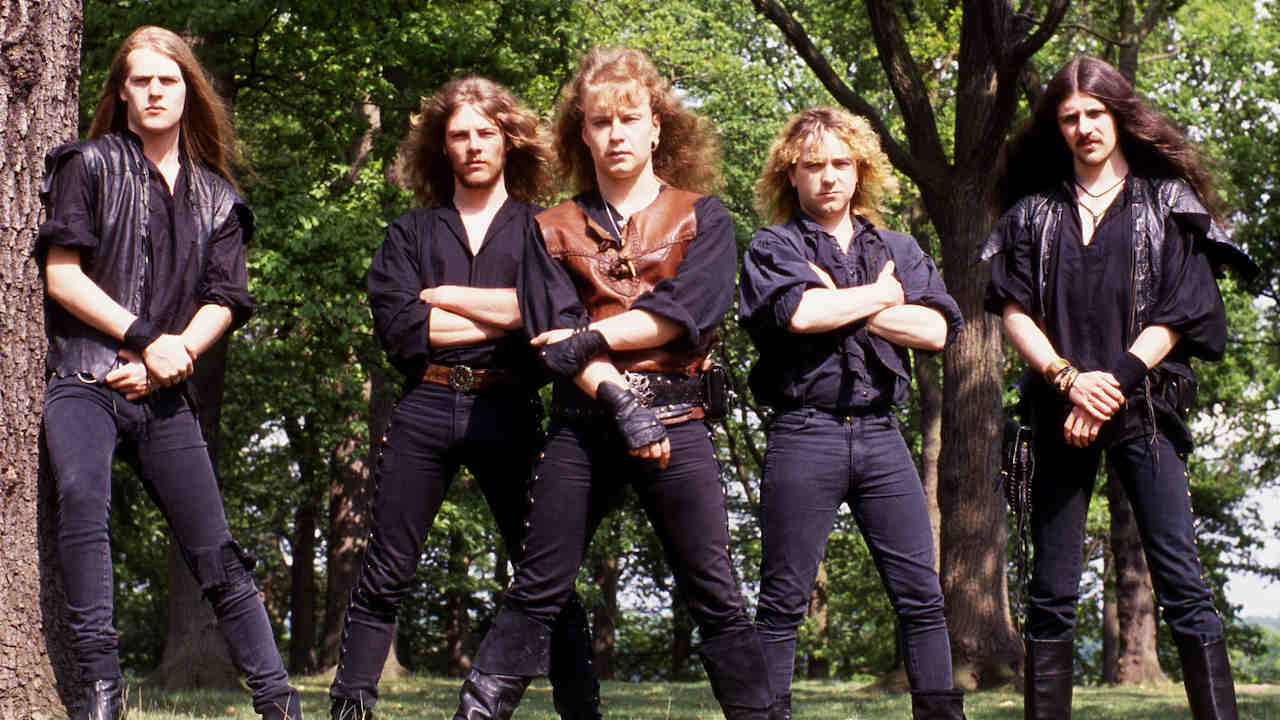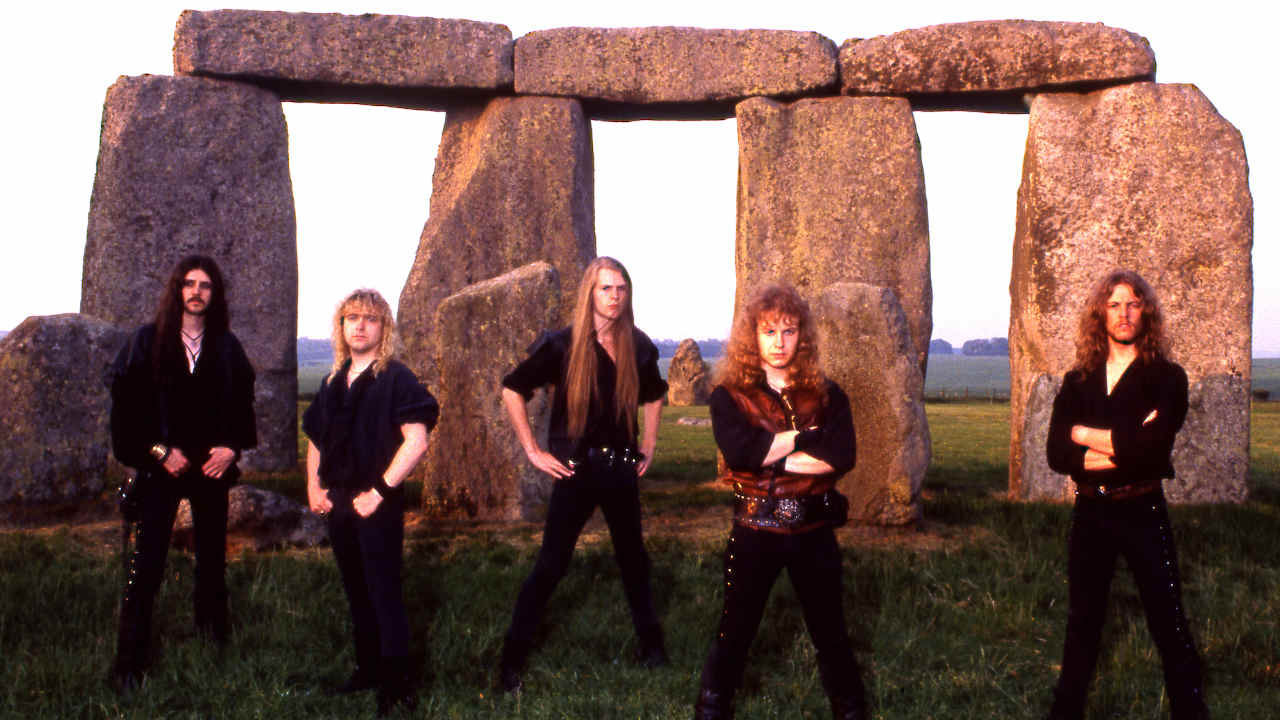
The late 80s was a tough time for British metal. While the rest of the planet seemed to be throwing up new thrash bands at a frightening pace, what did we have to offer? Well, if circumstances had played out differently, there was one band who just might have competed with their peers from the US and Germany: Sabbat.
The Nottingham band offered something that was musically fresh, diverse and innovative. Mixing pagan ideas with deeply-set folk and progressive influences, plus a sonically theatrical dynamic, they threatened to take thrash metal to a new level.
Sabbat started as Hydra in June 1985, with vocalist Martin Walkyier, bassist Fraser Craske and guitarist Andy Sneap. The arrival of drummer Simon Negus, replacing Mark Daley, who left at the same time as second guitarist Adam Ferman, coincided with a name change to Sabbat.
Two demos, Magik In Theory And Practice and Fragments Of A Faith Forgotten, not only got the young band major media attention, but led to a deal with celebrated German label Noise Records (amusingly, the deal couldn’t be signed until Sneap turned 18). Their debut album, 1988’s History Of A Time To Come, underlined the foursome’s class, creativity and loud clout. By the end of that year, they’d become a permanent five-piece with the addition of guitarist Simon Jones (formerly with Darlington’s Holosade), all of which set up what should have been the big international breakthrough, their second album Dreamweaver: Reflections Of Our Yesterdays. A concept album, no less.
“I had read a novel called The Way Of Wyrd by Brian Bates, and thought it could be easily adapted to Sabbat,” recalls Walkyier. “I was always into the idea of doing concepts anyway, and the rest of the band were up for that idea.”
A fantasy story set in pre-Christian England, the spirituality and Pagan philosophies in the 1983 book appealed to the singer. In the meantime, Sneap had been working up a lot of musical ideas.
“I had loads of riffs and arrangements already worked out,” says the guitarist. “They were more involved than had been the case on our debut, but that was to some extent because I was trying to keep myself entertained. I had no problem with the idea of a concept album. I was into King Diamond and Mercyful Fate, so went along with Martin on this one. I did read The Way Of Wyrd, and enjoyed it. Not exactly what I was into, but Martin did an amazing job in fitting the whole story into the lyrics.”

Putting together the words and music was a comparatively smooth operation, although Walkyier was still finishing off the lyrics when Sabbat relocated to Noise Studios in Berlin. They were working going to work with producer Roy Rowland who had been behind the desk for the debut.
“We wanted to use Roy again, although in the end I think he was the wrong choice,” admits Walkyier. “That’s typical of us, always making mistakes back then. The thing is that everything about Dreamweaver… suggests, even now, that it could have been a great album – except the production. Maybe it was too complex for Roy, I’m not sure. You’ve also got to remember this was before computers were being used – everything was on two-inch tape which caused its own problems. The tracks which bookended the album, the opening and closing ones, started to wear out on the tape.”
“We had two weeks in Berlin before we could even record,” says Sneap. “Roy was waiting for a delivery of acoustic tiles because the studio sounded awful. Noise had bought it from Tangerine Dream and ripped out a carpet that was in there. It was replaced with a pine floor and, as the ceiling was low, the sound was dreadful. A great start for us, especially when you consider that Noise were charging us for studio time while Roy waited for those tiles!”
Eventually the band spent six weeks in Berlin, with Walkyier and Sneap staying on for the mixing process. “Things were getting out of hand,” laughs Sneap. “There were objects flying out of fifth floor windows, microwaves being blown up and lots of drunken behaviour. So, it was decided to send the other three guys home.“
It didn’t help that Sabbat had virtually no money to ease the pain of Berlin. “We each got the equivalent of £3 per day, which meant that we could barely afford to eat anything!” recalls Walkyier. “I guess that was typical of the way Noise treated us. There was no financial commitment at all from their end. Having signed us, the label didn’t show any interest in what we did. I still believe that had Noise bothered with Sabbat, then Dreamweaver… would have been really successful, and we’d have gone on to have a great career. The plus side to this was that they never interfered artistically – we just got on with things the way that we wanted.”
“The problem that we had was that there was no-one looking after us,” Walkyier continues. “We needed a manager at the time, someone who’d be our big brother and deal with the money. All of us were so young and naïve that we had no clue how to manage finance. Every tour we’d come home having lost money. It was crazy. Noise did suggest one possible candidate, but none of us thought he was right for the band. So we went through all of that era with nobody to turn to.”
Dreamweaver… was released in June 1989 to a strong critical reaction and decent sales. Its combination of Sneap’s complex riffs, Walkyier’s distinctive half-snarled vocals, and the singer’s in-depth pagan-centred lyrics, it sounded like nothing else out there.
But while Sabbat may have reached new artistic heights with this record, it also signalled the death knell for the line-up that recorded it. Walkyier and Craske left following a tour with Manowar, with the singer citing musical and financial reasons.
“There are stories that I quit Sabbat because the rest of the band didn’t like my Pagan lyrics. That’s not true,” clarifies Walkyier. ”All of us shared an interest in that side of things. The Paganism was never a problem. I was always left to get on with the lyrics in the best way that I saw fit. No, the truth was that I could see the music was going to get even more complex. Andy was writing 11-minute metal epics, and I couldn’t even begin to see how I’d write lyrics for something like that. I wanted to explore other musical styles, to bring in violins for instance. That would never have worked with Sabbat.
“The other trouble was that I was broke. It wasn’t too bad on the road, when you’d get your food and drink. But I was living at home on £27 a week income support, and my girlfriend was pregnant with my son. I just couldn’t go on like that.”
Sneap and Negus continued under the Sabbat banner without them, recruiting US singer Richie Desmond, bassist Wayne Banks and second guitarist Neil Watson, who replaced the departed Simon Jones. This short-lived line-up released 1991’s critically mauled Mourning Has Broken album before splitting (Sneap later conceded the record should never have come out under the Sabbat name).
After his departure, Walkyier formed Skyclad, whose blend of metal and folk would prove hugely influential.The singer, Craske and Jones reunited in the late 1990s under the name Return To The Sabbat – Sneap, who was starting out on a career as an engineer and producer, blocked them from using the Sabbat name, aggrieved that he and Negus had been left with in debt following their former bandmates’ depatures. But by 2006, any lingering tensions had been put aside for a full reunion, supporting Sabbat devotees Cradle Of Filth at a handful of dates. While there were never plans to record, the band fell apart once more due to an argument between Walkyier and Sneap.
Sabbat have remained inactive since then, though Dreamweaver… has subsequently been held up as a cult British metal classic, even if Walkyier and Sneap have mixed feelings about it.
“The songs and musicianship are still really strong,” says Walkyier. “I can’t fault them. But the production… you can hear holes all over the place And I also feel the overall feel of the record is too complex. Maybe part of the problem was that we were trying to cram too much into about 40 minutes.”
“Basically, we packed so many riffs onto the record; I think there must be about 20 on each track,” says Sneap, whose production and mixing credits includes albums by by Machine Head, Arch Enemy, Killswitch Enagage and Judas Priest, the latter of whom he subsequently joined as touring guitarist. “What this album ended up being was Martin screaming poetry over loads and loads of riffs. If a band came to me today with these ideas, I’d pull it apart and get them to rethink the songs. But, we were so young back then – I was barely 20 – that we didn’t have the experience. One thing that does come through is what a clever lyricist Martin was – and is. There’s nobody who can touch him, in the way he uses words.
There’s little doubt that Dreamweaver: Reflections Of Our Yesterdays is the story of an opportunity lost. In differing circumstances, this could have transformed British thrash.
“It’s a record of its time,” says Sneap. “Despite all the obvious mistakes, it seems the fans still love it, and it was a very challenging project.”
Originally published in Metal Hammer 161. Updated May 2024







